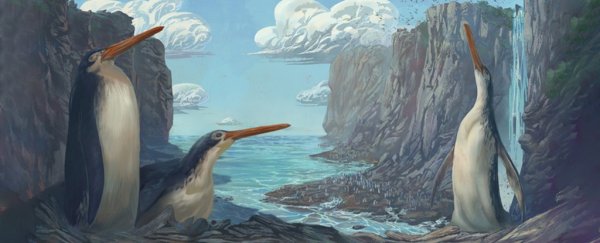Ancient New Zealand has been home to an incredible array of absurdly large birds. This has included a waist-high parrot, nicknamed Squawk-zilla (Heracles inexpectatus) – the largest parrot ever known on Earth, possibly hunting for flesh around 20 million years ago.
Two-meter-high flightless Moa also made their home there, along with their predator, Haast's Eagles (Hieraaetus moorei), with a monstrous 3-meter wingspan, around 2 million years ago.
Now researchers have added a new giant penguin to this gloriously super-sized menagerie – one discovered by a lucky group of school kids back in 2006.
"It's sort of surreal to know that a discovery we made as kids so many years ago is contributing to academia today. And it's a new species, even!" said Steffan Safey, who was one of the children on the Hamilton Junior Naturalist Club's field trip at the time. "Clearly the day spent cutting it out of the sandstone was well spent!"
Within a now solidified layer of what once was muddy siltstone, the students discovered the fossilized remains of the towering penguin's torso, leg, and arm bones.
Massey University paleontologist Simone Giovanardi and colleagues have now examined and formally described the find, found in rock from around 30 million years ago, in Kawhia Harbour on the North Island of New Zealand.
"The penguin is similar to the Kairuku giant penguins first described from Otago but has much longer legs, which the researchers used to name the penguin waewaeroa – Te reo Māori for 'long legs'," explained zoologist Daniel Thomas from Massey University.
"These longer legs would have made the penguin much taller than other Kairuku while it was walking on land, perhaps around 1.4 meters tall, and may have influenced how fast it could swim or how deep it could dive."
An analysis of living and extinct members of the penguin's family trees suggests these species reached their large proportions independently from each other. Natural selection seems to have an interesting habit of shaping birds into giants when they're isolated in a habitat free of predators.
Somehow, when Zealandia split from Gondwana 80 million years ago, it was (or soon became) free of predatory mammals, making it an ideal melting pot for such evolutionary experiments.
At least 10 known ancient giant penguins have been found on this continent, including the 60-million-year-old, 1.6-meter-tall Crossvallia waiparensis discovered in 2019, and 30-million-year-old Kairuku waitaki, that's related to the new find.
Some researchers suspect after having survived the extinction of non-avian dinosaurs 66 million years ago, penguins were able to take advantage of the lack of giant marine predators.
Left with plentiful resources needed to support bigger bodies, they were able to expand into new ecological niches – an ecological phenomenon called mesopredator release.
This roughly coincided with their shift into becoming flightless divers – flight would also have constrained their size. And without predatory land mammals around, the giant penguins had a safer place to breed in Zealandia.
Comparing the fossil to other species, Giovanardi and team note that following K. waewaeroa there was a trend towards shorter legs in this group of penguins. The change in body length may decrease the bird's surface/volume ratio and the surface area for parasites, both of which would reduce drag for their underwater flight.
Once other marine predators like sharks and marine mammals got big during the Eocene and Oligocene, any edge provided by swimming faster would have become a vital advantage again for these birds.
"Kairuku waewaeroa is emblematic for so many reasons," explained Thomas. "The fossil penguin reminds us that we share Zealandia with incredible animal lineages that reach deep into time, and this sharing gives us an important guardianship role.
"The way the fossil penguin was discovered, by children out discovering nature, reminds us of the importance of encouraging future generations to become kaitiaki [guardians]."
This research was published in the Journal of Vertebrate Paleontology.
